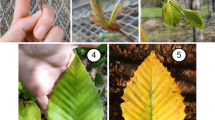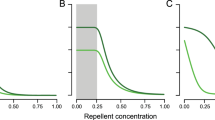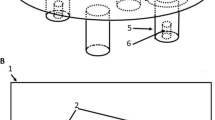Abstract
We describe a method using paraffin oil solutions and gas chromatography to measure and correct for differences in volatility among test compounds applied to filter paper and to address the problem of minimizing solvent contributions to EAG responses. To examine the effect of the volatility bias, we evaluated the EAG responses of female fir coneworm, Dioryctria abietivorella, to five volatile plant compounds, using a new method to normalize EAG responses to account for the loss of antennal sensitivity that occurs over time. Stimuli were generated either from equimolar (uncorrected) solutions or from corrected solutions that were adjusted to yield equimolar airborne concentrations in the air puffed over antennae. When uncorrected solutions were tested, the two most volatile compounds, (E)-2-hexenal and (E)-3-hexenyl acetate, elicited significantly larger EAG responses than three terpenes. When corrected concentrations were tested, the ranking of these responses changed: (E)-2-hexenal elicited significantly smaller EAGs than (−)-α-pinene, (−)-limonene, and (E)-3-hexenyl acetate. On the other hand, there was no effect on the ranking of EAG responses to the two monoterpenes and a sesquiterpene, (−)-trans-caryophyllene, relative to each other. Normalization of EAG data did not affect the overall results (i.e., stimulus rankings) but did reduce their variance within preparations. The results show that when compounds with widely different volatilities are compared in olfactory bioassays, the concentrations of test solutions should be adjusted to produce emissions with equimolar airborne concentrations.
Similar content being viewed by others
REFERENCES
Averill, A. L., Reissig, W. H., and Roelofs, W. L. 1988. Specificity of olfactory responses in the tephritid fruit fly, Rhagoletis pomonella. Entomol. Exp. Appl. 47:211-222.
Barrow, G. M. 1988. Physical Chemistry. McGraw-Hill, New York.
Bengtsson, M., Liljefors, T., Hansson, B. S., LÖfstedt, C., and Copaja, S. V. 1990. Structure-activity relationships for chain-shortened analogs of (Z)-5-decenyl acetate, a pheromone component of the turnip moth, Agrotis segetum. J. Chem. Ecol. 16:667-684.
Blackwell, A., Dyer, C., Mordue (Luntz), A. J., Wadhams, L. J., and Mordue, W. 1994. Field and laboratory evidence for a volatile pheromone produced by parous females of the Scottish biting midge, Culicoides impunctatus. Physiol. Entomol. 19:251-257.
Brockerhoff, E. G. 1998. Host location and oviposition in Strobilomyia spp. (Diptera: Anthomyiidae) infesting spruce cones. PhD thesis. University of Toronto, 107 pp.
Dickens, J. C., Billing, R. F., and Payne, T. L. 1992. Green leaf volatiles interrupt aggregation pheromone response in bark beetles infesting southern pines. Experientia 48:523-524.
Guerin, P. M., and Visser, J. H. 1980. Electroantennogram responses of the carrot fly, Psila rosae, to volatile plant components. Physiol. Entomol. 5:111-119.
Hartlieb, E., and Rembold, H. 1996. Behavioral response of female Helicoverpa (Heliothis) armigera HB. (Lepidoptera: Noctuidae) moths to synthetic pigeonpea (Cajanus cajan L.) kairomone. J. Chem. Ecol. 22:821-837.
Hoskovec, M., Kalinova, B., Konecny, K., Koutek, B., and Vrkoc, J. 1993. Structure-activity correlations among analogs of the currant clearwing moth pheromone. J. Chem. Ecol. 19:735-750.
Jang, E. B., Light, D. M., Dickens, J. C., McGovern, T. P., and Nagata, J. T. 1989. Electroantennogram responses of Mediterranean fruit fly, Ceratitis capitata (Diptera: Tephritidae) to trimedlure and its trans isomers. J. Chem. Ecol. 15:2219-2231.
Light, D. M., Kamm, J. A., and Buttery, R. G. 1992. Electroantennogram response of alfalfa seed chalcid, Bruchophagus roddi (Hymenoptera: Eurytomidae) to host-and nonhost-plant volatiles. J. Chem. Ecol. 18:333-352.
Mayer, M. S. 1993. Responses of three antennal specialist neurons of male Trichoplusia ni (Hübner) to sex pheromone components at and above naturally emitted levels. J. Insect Physiol. 39:401-412.
Raffa, K. F., and Steffeck, R. J. 1988. Computation of response factors for quantitative analysis of monoterpenes by gas-liquid chromatography. J. Chem. Ecol. 14:1385-1390.
Shu, S., Grant, G. G., Langevin, D., Lombardo, D. A., and MacDonald, L. 1997. Oviposition and electroantennogram responses of Dioryctria abietivorella (Lepidoptera: Pyralidae) elicited by monoterpenes and enantiomers of eastern white pine. J. Chem. Ecol. 23:35-50.
Steel, R. G. D., and Torrie, J. H. 1980. Principles and Procedures of Statistics. McGraw-Hill, New York.
Systat. 1992. Systat for Windows: Statistics, Version 5. Systat, Inc., Evanston, Illinois.
Visser, J. H. 1986. Host odor perception in phytophagous insects. Annu. Rev. Entomol. 31:121-144.
Weast, R. C. (ed.). 1970. Handbook of Chemistry and Physics. The Chemical Rubber Co. Cleveland, Ohio, pp. D146-D172.
Wilson, E. O., Bossert, W. H., and Regnier, F. E. 1969. A general method for estimating threshold concentrations of odorant molecules. J. Insect Physiol. 15:597-610.
Author information
Authors and Affiliations
Rights and permissions
About this article
Cite this article
Brockerhoff, E.G., Grant, G.G. Correction for Differences in Volatility Among Olfactory Stimuli and Effect on EAG Responses of Dioryctria abietivorella to Plant Volatiles. J Chem Ecol 25, 1353–1367 (1999). https://doi.org/10.1023/A:1020930910416
Issue Date:
DOI: https://doi.org/10.1023/A:1020930910416




